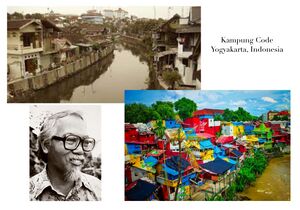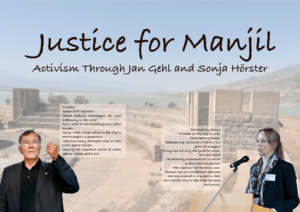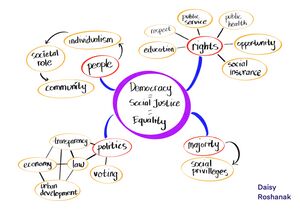Democratic Landscape Transformation 2023 - Team 10
>>> Back to working group overview
>>> Back to seminar reading list
>>> go to the Editing Help
Background of your team
- Please write a few words about your team.
- Which linguistic and cultural perspectives are you representing? Which disciplinary backgrounds?
Daisy Corleona Yoval : IMLA student - B.A. in architecture from Universitas Pelita Harapan, Indonesia. Architect and event designer.
Roshanak Gharavi Manjili: IMLA student - B.A. in architecture from University of Guilan, Iran. freelance architect and designer.
Your Landscape Democracy Manifestoes
Here you can add links to the manifestoes you have presented on April 26
- Roshanak’s Manifesto https://docs.google.com/presentation/d/1uxDP5AY5rQjb8ObGvi-ve6lqFjWgLSM7/edit?usp=share_link&ouid=110943451438352384570&rtpof=true&sd=true
- Daisy’s Manifesto https://drive.google.com/file/d/124zll73YVqHkbgm9U4JZoVN6yATnc98O/view?usp=sharing
- add link here
- add link here
Examples of Landscape Activism
In the session on May 10 you will discuss examples of landscape activism from your own contexts. You can share the examples in this section (link, image and/or short explanation).
Roshanak’s Landscape Activism
I lived in a small city called Manjil, in Iran, where there aren’t many amenities. So many children don’t have enough space to play team sports together. They have to take the initiative to make their own playground and football pitch. Although the land they chose is sometimes not accessible due to rise in water levels, they don't give up and use it as much as they can.
Most of the children in smaller cities of Iran have to play on the streets or in alleys where there are many cars passing by. Since there are not enough parks, green spaces and playgrounds for the children to play safely, they have to use what they have.
Daisy’s Landscape Activism
This area is called ‘Kampung Code’. It is located in Yogyakarta, Indonesia. The movement is initiated by Yusuf Bilyarta Mangunwihaya or known as Romo Mangun. This project was initiated in the at 1980s during the new order regime. At that time there was duality function in which the military officers could have a position in the government and they treated the poor people poorly. At first poor people who lived in the area were homeless who built their home with cardboards and scrap materials. That caused them problems when there’s a heavy rain which caused the river to flood and washed their ‘homes’ away.
Initially the government wanted to demolish the area. However, he is a strong believer that the people deserve to have a home and good well-being despite their economic condition. So he proposed that he will build the village with the locals. He educated the locals in building proper houses that suits the climate. In order for the people to still have their home in the area.
Until this day, the locals do not know where Romo Mangun was able to provide the materials to build their homes. Because they only provided the energy to build their home. This project was considered a big movement at the time and they won Agha Khan award in 1992. Up until this day, this project still generate income for local tourism for the locals.
The Role Play
In the session on May 17 you will present a small role play with your team. Please add here a short reflection on what you have learned from this play. The short list of landscape democracy 'movers and shakers' can be found here
- google doc for our short notes on selected activists:https://docs.google.com/document/d/1-o5Qb3XLBuV9arKKZvPJei8MJyN7ZnKML5tRTj6lQbg/edit?usp=sharing
>>> All information on the phase B activities is compiled in this PDF
Readings, concepts and definitions
- Start: April 5, 2023
- Due: July 5, 2023
Working in your group, express your personal understanding of the relation of landscape and democracy in the form of a concept map with linking words or any other diagrammatic representation. Please make your maps very visual and not just verbal. Think critically about why one map differs from another
About concept mapping
Before starting the exercise you can read this article by Joseph D. Novak & Alberto J. Cañas about Theory Underlying Concept Maps and How to Construct and Use Them. This paper gives a good explanation of how concept maps are conceived and developed.
You can use any tool you like for producing your concept map. However, since the result needs to be submitted digitally we recommend the following open source software for producing your maps:
- Cmap Tools >>> you can also work with your group on the Cmap cloud doing a shared map
- VUE - The Visual Understanding Environment
Please add your concept map(s) here
- Possible format: JPG (for wiki upload) or link to any other resource
- You may add one map per team member or an integrated one
- add as many additional materials as you need
Please finish with a short reflection
- What are the similarities and differences in your team regarding your understanding of what democratic landscape transformation is?
- In how far did the seminar lectures and readings help you to clarify this?
- What will you take home from this seminar?
We have similar understanding about the landscape democracy. The only difference is the intensity of how bad the democracy is in our respective countries.
This seminar taught us how to make participation and how to be involved in the community. How powerful it is to speak up and make impact (based on our experience in the landscape forum). It is beautiful that a cause could bring people together and fight for the same cause.
The seminars inspired us to make activism and it does not have to be done in a big scale. We can do tiny actions which impact our closest surrounding and hopefully the actions will ripple and create a bigger impact.
Daisy & Roshanak


